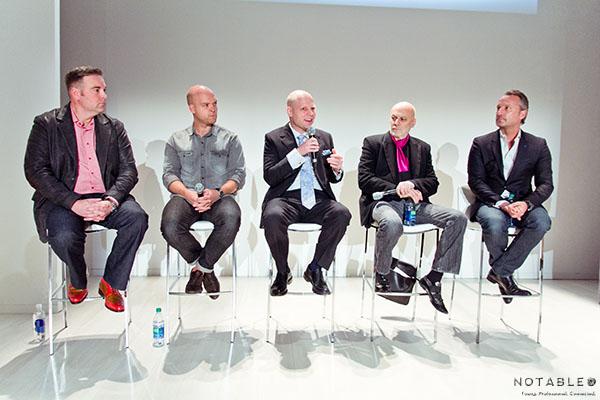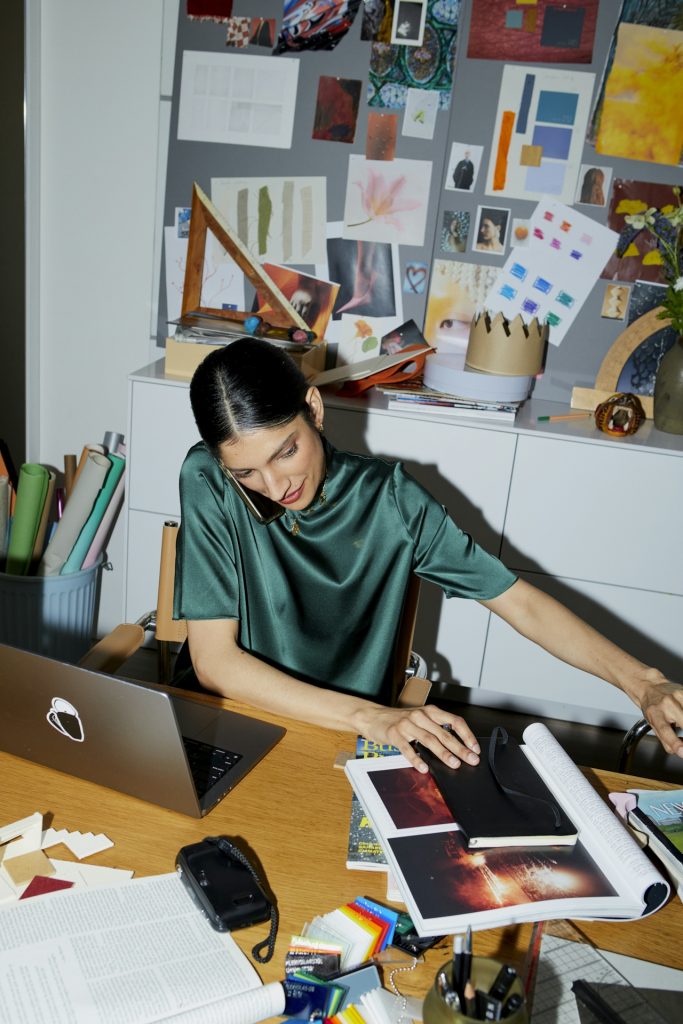It’s not all glamourous when it comes to the fashion industry. As a new designer, you not only need your talent, creativity and vision, but a strong business sense as well. A few weeks back, we were at the DHL Fashion Industry Panel at Toronto’s World MasterCard Fashion Week. Now in its third season, the seasoned panel, which consisted of Canadian designers and industry executives, discussed the business side to fashion and offered advice for young designers, a lot of which can be applied to starting any business. This means everything from financing, to the role of social media, initial challenges and pitfalls, plus a lot more.

The panel consisted of:
Adam Taubenfligel, Triarchy
Stephan Caras, designer
Jarrad Clark, Global Creative Director at IMG Fashion Events and Properties
Greg Hewitt, President of DHL Express Canada
Mark Zimmerman, Senior Business Advisor at MaRs
Leesa Butler, Fashion Group International, moderated the discussion.
On getting your business off the ground:
Greg: The first step to creating a small business starts with a 1, 3 and 6-year plan. You have to really know your market and who you plan to target. Do you have the customer base? In terms of financing, do you have the funds to get you through the first year minimum? Do you have the supplies? Do you have all the logistics planned out about how to get your product into the market?
Stefan: There are three main things that are required. The first is a good team. Creating a label is a team sport – it’s not just up to the designer. A strong team is essential, as in the case of building any business. Secondly, there needs to be a market and knowledge of this market, which is accomplished through research. Finally, there obviously needs to be a quality product.
Mark: You need to have the money. You need to see risk capital as continuous. At the start, you are reliant on the “three Fs” – friends, family and fools. These are people who you can get support from, including financial. Otherwise, you can extend your credit card limit; go into debt, the whole thing. But if you start with backing, and assuming your brand is met with success, you can then apply for things like grants, etc.
Stefan: You really need to learn from your mistakes early on, because the next time could be costly. Things were a lot easier when I started 20 years ago. You need total commitment. It isn’t enough to be financially backed for only one year. You need to be backed for three in the fashion industry because you work on things so far ahead. Your short-term vision must be matched with your five-year plan. It will probably take you five years in the business to become kind of established. Throughout those first five years, you need to be getting by, but there needs to be constant improvement.
Adam: I wouldn’t focus on mistakes as much as I would stress the importance of learning. For example, some prototypes don’t always work and sometimes you don’t know why. I think it’s smart to launch in a local market, to start small and not to get in over your head. It’s a more manageable market. You can learn from mistakes made here and make the appropriate changes to take you further.
Mark: When working with new business models, adapting is always hard. Passion and vision is what keeps people going. There is always a tension between objectives and being flexible with your vision. You need to keep your business plan alive and not gathering dust. I think we need to think about changing the business model canvas. I like the one page way of a business plan. If the business plan can be contained to a single page, it means it’s less resistant to change. It’s easier to alter one page. It’s important to preserve your nimbleness. You need to be open to change. There needs to be a balance between acting your vision out as planned and how to realistically achieve your visions. You sometimes have to give your artistic vision up to others. You’re not going to be the one making all the changes, so you need to accept that.

On the role of e-commerce:
Greg: E-commerce is increasingly a huge part of the business. To say that it is booming would be an understatement. I would say more than 50 per cent of the business we do is online. The ability of purchasing online, of course, allows us to tap into markets that aren’t close to home. E-commerce is good in that it allows transparency, people can understand the actual cost of the landed good. At the same time, this means that you need a system that can integrate with web portals and platforms. Traditional brick and mortar models are not the same as they used to be as a result – but it won’t all go online. There will always be some sort of retail presence. The challenge is how to integrate online with retail and the supply chain to deliver to the customer as efficiently as possible.
Adam: With e-commerce, you still need to start small. Focus on the local for the first year. Don’t get ahead of yourself, start slow and steady, and grow into the market organically.
Stefan: On the contrary, I realized that the Canadian market was super small from the start, but we are lucky enough to have the US right there. I almost didn’t pay attention to Canada; I always thought bigger. Social media now is key. Now, people are demanding clothes from over 50 countries because of social media. Now we have a global audience.

On social media:
Jarred: Social media is important but needs to be used strategically. It is important not to overwhelm or bombard. You need a well-rounded social media strategy and you can’t lose that. I think its nice when you can create a fan base with bloggers and develop a relationship with that type of media, so it’s third-party promotion. Then you get their readership as opposed to only your customer base.
Stefan: Aside from shows, the most powerful tool to promote yourself is through social media. Shows cost a lot of money, after all. A lot of my shows can be seen in other countries now solely because of social media. A Vogue ad 20 years ago would cost $200k. One show now means huge exposure thanks to social media.

On the potential pitfalls of starting a business:
Mark: Some of the pitfalls of business are when businesses grow too fast. You need to be ambitious but prudent at the same time. It’s all about balance. You need to grab a hold of the market, but not the country all at once. Target your city first.
Jarred: No matter what, you need a quality product. With the entire process now online, your ego can’t become larger than your collection. Sometimes, you can read the positive press about yourself and believe it all. It can get to your head. Remember who you are. The hype can become contagious and a pitfall.
Greg: As a small business owner, you don’t have all of the expertise. There is so much that goes into managing a label, from legal to paperwork and customs when getting your stuff across borders. IMG helps from the supply chain POV.

On promotion:
Jarred: Retailers don’t give you a second chance. Often the foundation to business is in your own backyard, so don’t jump borders too quickly. Be strategic, the competition is stiff. For example, 5000 students graduate from fashion programs in the UK each year. Fashion shows are only one way to showcase your brand. Take advantage of other forms of entertainment like film and events, along with shopping nights and the various online platforms.
Stephan: Now more than ever it’s so easy to create your own content yourself and to shoot your own content. Each time we travel, we make a look book and send it to our blogger relations.

On fashion shows:
Jarred: Work with friends and family to begin when it comes to the fashion show as you’re forming your long-term partnerships. The most important thing is consistency with the vision. You can’t cut corners easily when it comes to a fashion show. You need quality models, and quality photos and videos so that you may use those for six months of marketing. It’s worth the investment.
Stefan: The problem happens with logistics. When I was first starting, my biggest problem was that I had no money. I had to get models for free, people to work for free in terms of sound and lighting, and I still couldn’t afford the venue. I had to charge my friends to see the show. It’s all about chemistry and balance. Be creative and find ways; if there is a will, there’s a way.

On audience takeaway:
Jarred: Have a good team who you can trust and who share the same vision as you. You need a team who you can experience the highs and lows with and who will keep you on the right track.
Stephan: Passion is the most important element. If you’re passionate, you will find a way. If that’s not today, it will happen tomorrow. Without passion you won’t survive a year.
Mark: Passion is important, but it’s also important to be open-minded about your path that you take. It’s not always a linear journey; it’s filled with twists. You need to be open to these twists and make your own.
Adam: Have a small, good and strong team. I mean, I work with my brother and sister. Partner with someone who understands the business. Be open to criticism and lose your ego. Be able to respond to the market.
Greg: It’s important to recognize your strengths and weaknesses and decide who can best handle your weaknesses. Leverage partnerships from others to grow, like IMG and FGI. They will help you meet like-minded businesses. Work with others and talk to other small business owners.
Stefan: You must have the proper knowledge. The biggest mistake people make is that they think a university degree makes them a designer. You can’t learn to be a designer, though, you either have it or you don’t. School is practical. You need to show that you can do it for others to believe it as well. Work for a designer as an apprenticeship if you can. That’s what all great European designers did. We don’t tend to do that as much anymore for some reason. Find a mentor, a designer with knowledge, and work with them and study what they do. One day you will have the knowledge to do it yourself.
Jarred: Designers from Europe are successful because they do internships. You can’t come at it after school ends and expect to know all.
Adam: A mentor is so important in everything from opening doors to acting as a sounding board.







